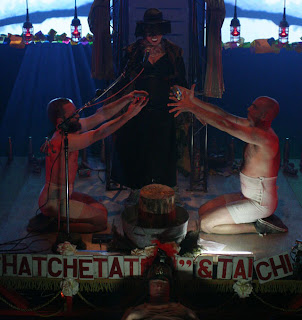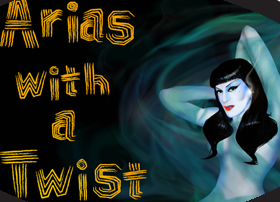 There is a visually stunning and not very well publicized production at La Mama that will be running through September 28. Atomic City is a clever composit of dance, theater and live music that takes spectators into the lives of two neighboring families whose troubled patres familias both work as physicists in the town’s laboratory. The plot of the performance unravels slowly, as we learn about the characters’ relationships to each other, and observe them interacting through dance, words and song. Indeed, one of the strongest aspects of the piece lies in the balance of different performance forms that take turns at telling the story. For example, just as a spoken introduction to the piece seems to point us in the direction of a wordy theatrical work, the nimble bodied orator (Karl Sørensen) ends his prologue and throws himself into an extremely physical dance phrase filled with suspensions and inversions, all emphasized by a spotlight that gives his dance a dramatic twist.
There is a visually stunning and not very well publicized production at La Mama that will be running through September 28. Atomic City is a clever composit of dance, theater and live music that takes spectators into the lives of two neighboring families whose troubled patres familias both work as physicists in the town’s laboratory. The plot of the performance unravels slowly, as we learn about the characters’ relationships to each other, and observe them interacting through dance, words and song. Indeed, one of the strongest aspects of the piece lies in the balance of different performance forms that take turns at telling the story. For example, just as a spoken introduction to the piece seems to point us in the direction of a wordy theatrical work, the nimble bodied orator (Karl Sørensen) ends his prologue and throws himself into an extremely physical dance phrase filled with suspensions and inversions, all emphasized by a spotlight that gives his dance a dramatic twist. The cast for Atomic City is also a combination, a mix of artists with different backgrounds and nationalities: there are two musicians from Sweden, two Danish dancers, a physical theatre performer from Guatemala, and an acrobatic dancer and mover from the US. More generally, the work is a collaboration between the Danish company Terranova and US performer and producer Jon Morris (Fuerzabruta, Cirque du Soleil). They produced the piece in an intensive residency this summer at Robert Wilson’s Watermill Center, and this in New York is their premiere. Probably because the piece is so new, there is a raw quality to it that makes the work exciting: these artists are taking risks with their bodies and their voices, in a collaboration that has pushed each one of them to a new place in their artistic practice.
When something does not run so smoothly (some of the harmonizing could use a little more practice!) the visuals of the piece by and large make up for it. The set for Atomic City beautifully contrasts the darkness of the performance space with white panels of waxed paper and a green square of fake grass. Spectators sit on opposite sides of the square, a choice that is elegantly exploited several times during the performance by movable wall divisions and the different facings of the performers. Apart from one character, “the gatekeeper”, soberly dressed in grey shades, all the performers wear white costumes. The result is a bright and clean look, easily associated with snow or the stark light of an atomic explosion.
Atomic City is at once readable and abstract: “a recipe for pie and one for destruction”, as described in the flyers for the show. This young group of international artists from different disciplines has created a unique world within the La Mama Annex theatre, a white city in which, as one of the physicists claims, “we are suspended in language”, as well as in sound and movement. In this secret place, human relations unfold playfully and painfully through beautifully physical phrases of movement and broken fragments of language. With its light humor and poetic aesthetic, Atomic City is a promising collaboration, one that should not be overlooked.
The Annex
September 11 - 28, 2008
Thursday - Saturday at 7:30pm
Sunday at 2:30pm & 7:30pm
Tickets $25
purchase tickets online




